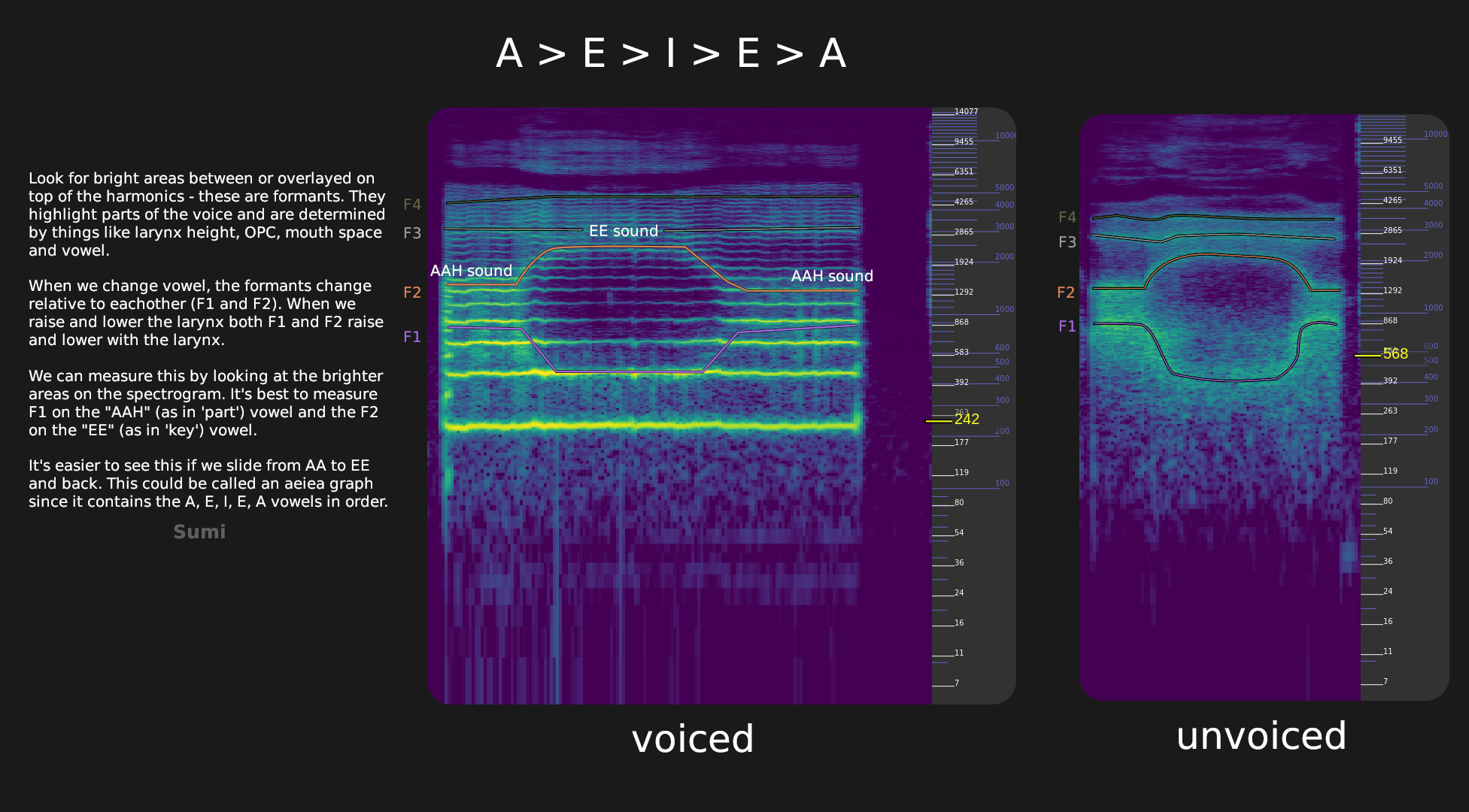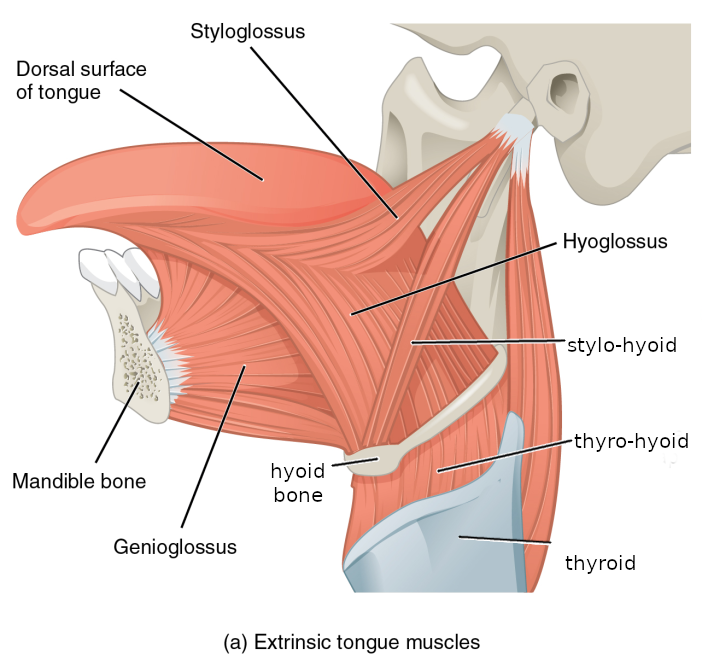This site is under construction! Stuff be missing, beware! Contribute!
If you have additions, corrections or concerns, open an issue or contact a maintainer.
Voice Map is released! See here for a giant map of (almost) all voice characteristics and pedagogy!Table of contents
Resonance
What is Resonance
The space in a container is it’s internal volume, like the air in a pipe. Resonance is how sound is affected by the shape and amount of that space. We hear this quality as low and high resonance or as brightness, which is the more perceptual equivalent. A low resonance sound will seem darker and booming, where as a high resonance sound will be bright or even buzzy in the extreme. Think of cartoon characters; a giant will have a booming, low resonance voice, whereas a goblin for example might have a high resonance voice.
Low resonance sound:
High resonance sound:
Every space has resonant frequencies. When a sound passes through that space, frequencies in the sound near the resonant frequencies of that space are filtered to be louder compared to the rest of the sound. You can hear a resonant frequency when you blow air across the lip of a bottle. The more water (and thus less air) in the bottle, the higher the whistle sound produced. Your vocal tract is similar to this fundamentally, though much more complex of course.
However, this is all just context. It’s best not to think about resonance as formants or physical space changes but just as how the voice sounds. We’re much better equipped to change sound color than we are to change physical aspects of our vocal tract.
Here’s a 32 second video explaining resonance:
Resonance Explained in 30 seconds
And here’s a more in-depth video on it:
Introduction to how resonance works
Brighter Resonance
To raise resonance and brighten the voice in general, using a combination of modifications.
Expand / Collapse
Voiced Resonance Stepping
In this exercise we start at a medium or high pitch, then:
- start at a low resonance yawn-like position and say a phrase or word like “one two three”
- relax and go to a neutral, not trying position and say the same thing
- get even brighter and say the same thing
- go into speaking a passage or speak naturally, letting it go from a darker sound to become brighter over the course of speech
- this will help you eventually “graduate” to being able to change resonance on the fly
This helps avoid pitch conflation (going up in pitch when changing resonance) and might be more natural and less constricted for some people.
Pitfalls
- changing pitch too much
- have a pause between each step, don’t slide
- picture the pitch when you speak
- going “buzzy” or overbright
- once you get to the brightest part, tone it back to a more balanced position
- don’t smooth it over or add breathiness
The voiced resonance stepping exercise
Whispers
We can just whisper a word over and over, and change how high or low it is. This isn’t pitch, but it’s the equivalent for unvoiced sounds. What we’re changing is resonance, and the level of resonance defines the ‘pitch’ of the whisper (again it’s not pitch, but for most people, this analogy makes sense). We go from a low, deep whisper to a higher whisper while repeating the word or phrase. We can then - very importantly - make it light and unconstricted. Best practice is to stop at this point and use voiced resonance stepping, but we can also go into speech from this point after a pause if that’s not giving results, but use “la” instead of “ha”.
Whisper for introduction to resonance
- whisper a word, like “whisper”
- make it lower and deeper
- make it higher and higher
- this should feel like normal breathing, so make sure it’s not tense or constricted, but instead, light and airy
- this can give you the basic ability to change resonance, and then you can use voiced resonance exercises to actually train it
Vampire slides
- make sure it’s not constricted; more air and less sound is good. It should feel like normal breathing
- once you’re at the top, pause and then say voiced “wa” or “la”
- the “la” and “wa” sounds reduce the roughness that could come in otherwise
- avoid using this for going into speech, do voiced exercises (like stepping) instead
Pitfalls
- constriction and tension
- make the high resonance position light and airy
- avoid going from unvoiced / whisper to voiced directly, instead go to the voiced resonance stepping exercise
- pitch conflation
- never do whisper based exercises on their own; do voiced ones at a set pitch immediately after
- this will help to reduce how much you change pitch when changing resonance and give you more range!
Whisper slides for higher resonance range
Darker Resonance
For making the voice darker and lowering resonance.
Expand / Collapse
uhh and iii
- say “iii” as in happy and notice the mouth is tight and the tongue is raised
- say “uhh” and notice the mouth is slack, open and everything is “spread out”
- this makes the mouth space a little bit larger and so reduces brightness
- it also reduces sibilants (S sounds etc); if you have bright sssibilantsss instead then it’s a sign of small mouth space and is more feminine
- you can then practice having this color the rest of your speech:
- say a phrase like “oak is strong” with the same sort of shape as the “uhh”
- say a phrase like “cats and dogs” with the “iii” shape
- notice the difference, then apply to general speech and notice how your mouth will be less “tight” when doing the darker “uhh” shape
- be sure to keep the larynx in vaguely the same position, since otherwise you might drop the larynx instead of making a large mouth space!
Haah and Haww
- say “haah” like normal, or bright
- say “haww” and let it become darker (think halfway between hot and hoot, with a relaxed / slack mouth posture)
- the more you keep the mouth in roughly this haww shape, the darker your overall speech will be
- experiment with the extremes, try extremely dark haww and bright haah
Compare dark vowels with bright vowels
- Bright: UK hack heat hut
- Dark: UK hurt hoot goal
- Bright: Access is granted in this easy hack
- Dark: Who hurt those old boots whose holes were sewn
- you can also do these mumbled and then overarticulated (hint: valley girl voice is usually overarticulated) to show small and large mouth space
Formants
Formants are frequencies of the voice that are highlighted because of the shape of the vocal tract. If a resonance is a property of the container, or space, then a formant is a property of the sound. There are two formants we really care about.
- First, and while it isn’t a formant itself, F0. F0 is your pitch, and it’s the fundamental frequency of your voice at any time.
- F1 is the lowest formant by frequency
- F2 is the second lowest formant
All resonances (and so, formants) will be raised by shortening the vocal tract, and lowered by extending it.

When we make different vowels, we move our mouth to change these formants so that the space between them is different, and that’s how we can tell what vowel someone is saying. Try saying “hat” and “hoot”. Notice one sounds brighter and one darker. In “hoot” we make the mouth longer by pushing the lips out slightly, and so more space and longer tube = lower resonance.
The following two sounds are at the same pitch (fundamental / F0), but at drastically different resonances. Larynx height isn’t the only thing changing here, but it has the most impact.
Low resonance sound:
High resonance sound:
Types of Resonance Modification
Larynx Height
Since the larynx houses the vocal folds, moving it up shortens the vocal tract and raises resonance. The sound is created further up the vocal tract. The larynx moving is considered the larger modification in resonance, where vowel would be smaller.
Vowel Shape
Vowels change formants. By changing the mouth shape we can access different vowels but also increase or decrease overall resonance by shifting vowels to a higher resonance vowel like /.ae/ as in ‘had’. We don’t need to actually change the whole vowel though, but just get the shape of the vowel to shift slightly toward a brighter one. This is usually called macrovowel.
OPC - Oropharyngeal closure
The back of the mouth, the palatopharyngeal arch can constrict to become a tighter space, which raises resonance. This can also encourage tongue root retraction which contributes to a cartoonish quality (see: Stitch voice).
OPE - Oropharyngeal expansion
Likewise, it can be expanded to lower resonance.
Mouth Space
By changing tension in a few places in the mouth we can achieve a brighter or darker sound. Imagine pulling the corners of the mouth back for an A vowel like in HAD, then keep the inward pressure from the cheeks but remove the expression. This when done properly with enough practice causes a fairly significant shift in brightness. A common way to achieve smaller mouth space is to use macrovowels to get the overall small or large shape and keep that chape and space when speaking.
Large mouth space, dark:
Smaller mouth space, bright:
Twang*
There are many ways to get a “twangy” sound. It can encourage nasality so it’s worth being aware of that. Twang adds upper frequency range information which means a brighter sound. It highlights parts of the voice around 2000-4000hz which is in the F2 range. It has a buzzy quality. This can add some brightness to a voice when added in very small amounts, so that we can go from a dark, soft sound to a bright crisp sound. It’s especially useful when imitating low pitch bright voices, and getting loudness at medium to high pitch without adding vocal weight.
Comparing not twangy meow sound with a twangy one:
Comparing loudness from airflow with loudness from twang:
Note on TH and SH Muscles
As a generalisation, when raising the larynx as a result of raising pitch, only the thyrohyoid muscles raise the larynx. Often when training resonance we use both the thyrohyoid muscles and the stylohyoid muscles. The stylohyoid muscles do add some resonance, but it typically isn’t as much as from the thyrohyoid muscles.
 The stylohyoid runs from top right middle to the hyoid bone, thyrohyoid runs from hyoid to the larynx (thyroid).
The stylohyoid runs from top right middle to the hyoid bone, thyrohyoid runs from hyoid to the larynx (thyroid).
If we have a situation in which the resonance cannot go above around 700hz F1 (/.ae/ vowel) then it’s highly likely that only the stylohyoid muscles are being activated. It can be useful then to use high pitch to gain activation of the thyrohyoid muscles and then lower pitch while trying to maintain that configuration.
Acoustic Resonance Details
A more detailed explanation of how resonance works physically can be found here: Acoustic Resonance
